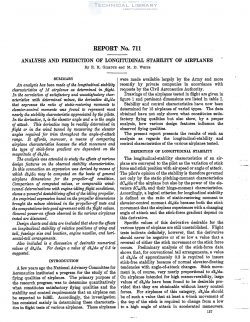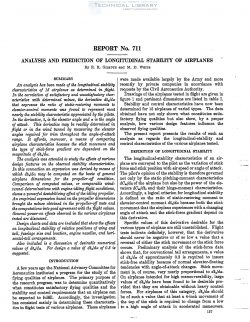naca-report-711

- Version
- 330 Downloads
- 898.83 KB File Size
- 1 File Count
- August 30, 2016 Create Date
- August 30, 2016 Last Updated
National Advisory Committee for Aeronautics, Report - Analysis and Prediction of Longitudinal Stability of Airplanes

An analysis has bee-n made of the longitudinal stability
characteristics of 15 airplanes as determined in flight.
In the correlation of satisfactory and unsatisfactory char-
acteristics with determined values, the derivative d6./da:
that expresses the ratio of static-restoring moments to
elevator-control moments was found to represent most
nearly the stability characteristic appreciated by the pilots.
In the derivative, 5. is the elevator angle and a is the angle
of attack. This derivative may be readily determined in
flight or in the wind tunnel by measuring the elevator
angles required for trim throughout the angle-of-attach
range. It aficrds, moreover, a means of comparing
airplane characteristics because the stick movement and
the type of stick-force gradient are dependent. on the
magnitude of elm/doc.
The analysis was extended to study the ejects of various
design features on the observed stability characteristics.
In this connection an expression was derived by means of
which dBJda may be computed on the basis of general
airplane dimensions for the propeller-of condition.
Comparison of computed values, or comparable wind-
tunnel determinations with engine-idling flight conditions,
shows a powerful destabilizing effect of the idling propeller.
An empirical expression based on the propeller dimensions
brought the values obtained in the propeller-of tests and
the computations into good agreement with the flight values.
General power—on effects observed in the various airplanes
tested are discussed.
Design charts and data are included that show the ejects
on longitudinal stability of relative positions of wing and
tail, fuselage size and location, engine nacelles, and hori—
zontal-tail arrangements.
Also included is a discussion of desirable numerical.
values of dtJda. For design a value of dGJda of 0.5 is
suggested.
A few years ago the National Advisory Committee for
Aeronautics instituted a program for the study of the
flying qualities of airplanes. The primary purpose of
the research program was to determine quantitatively
what constitutes satisfactory flying qualities and the
stability and control requirements that an airplane can
be expected to fulfill. Accordingly, the investigation
has consisted mainly in determining these characteris-
tics in flight tests of various airplanes.
| File | Action |
|---|---|
| naca-report-711 Analysis and Prediction of Longitudinal Stability of Airplanes.pdf | Download |
Comment On This Post